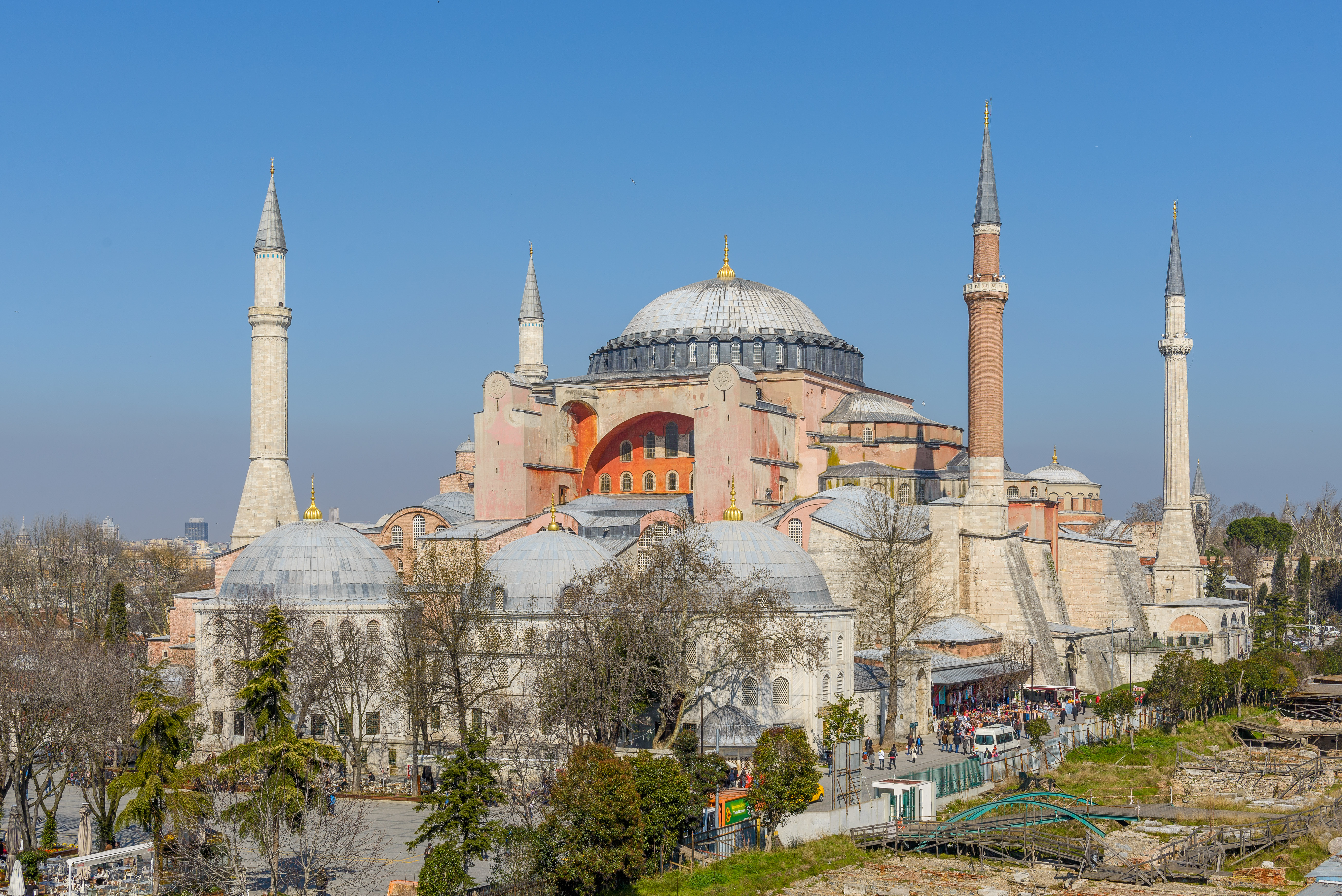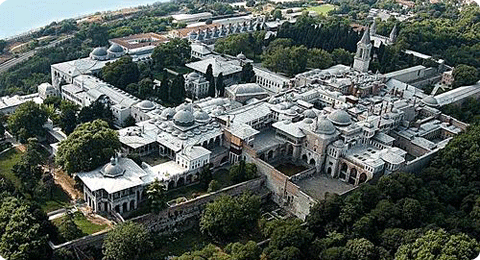Hello everyone! I'm currently wrapping up my little vacation to Istanbul, so this seemed like a good time for a new history update. This is my second time here, and I had much more time to explore and really take in the city. I've been thinking quite a bit about the city as it used to be, i.e. Constantinople. Of course, thinking about Constantinople is part and parcel of being a Byzantinist, but it becomes much more real when you're actually standing in the "Queen of Cities" as it stands in the 21st century.
Human settlement in what is now Istanbul dates back thousands of years, as you would expect in such an important location. Situated on the straits of the Bosphorus--the thin channel of water separating mainland Europe from Asia Minor--the site has always had great value for regulating the trade between the Near East and the rest of the Mediterranean world, as well as controlling the only entrance to the Black Sea. In the 7th century BC, Greeks from the city of Megara founded Byzantion, which would be the name of the city for around 1000 years. Then, in 330 AD, Constantine changed everything.
 |
| A statue of Constantine in York, England, a one-time capital of the Roman Empire |
In the early 4th century, the Roman Empire was a lot different than what you probably imagine. The time of Augustus was long gone, the Mediterranean world had been wracked by nearly a century of civil war and political usurpation, and the so-called "barbarians"--that is, anyone who lived outside the borders of the Empire--were pressing on the Roman frontiers to greater and greater effect. In the past many of the emperors had been politicians and even philosophers; now, only a soldier could be expected to hold onto the throne. In response to these problems--known as the "Crisis of the Third Century"--one of Constantine's predecessors, Diocletian, instituted massive reforms to the Roman system, including dividing the power of the emperor. Instead of a single emperor, Diocletian created a "college" of 4 emperors, who could more effectively govern the sprawling Imperium Romanorum.
 |
| This is the famous porphyry statue of the tetrarchs, which you may have seen if you've been to St. Mark's Basilica in Venice. It was looted from Constantinople in 1204 by the Venetians. |
Each of these emperors would be responsible for a separate section of the empire, and each would rule from a city of their choosing (based on strategic importance, of course). The city of Rome was no longer the seat of the empire, and it took on a purely symbolic importance. Instead, the "capital" tended to be wherever the emperor based his court.
 |
| Not the best map, but you can see a number of these imperial capitals. Notice how there aren't any along the southern Mediterranean: that's because there weren't any invasions coming from that direction, thanks to a little thing called the Sahara Desert. |
This system of tetrarchs worked by having the 2 senior emperors (the "Augusti") name their subordinates (the "Caesares"). When the senior emperor died, his junior would be elevated and then pick a new junior emperor, and so on and so forth. For a while this worked very well, and the problems of the Third Century became a thing of the past. Then, Constantius died in England while serving as the Augustus of the West. His Caesar should have taken his position, but Constantius' troops instead declared his son, Constantine, to be the new emperor. This was for all intents and purposes an illegal usurpation of power, and it set into motion a series of periodic civil wars that would last for nearly 20 years. When the dust settled, Constantine had eliminated all of the other members of the system of the tetrarchy, and the Roman Empire once again was under the rule of a single man. Shortly thereafter he set out to found a new capital--remember, Rome hadn't been strategically significant for decades (at least). He settled on the city of Byzantion, completely rebuilding the city in the process, and renaming it first Nova Roma, and eventually Constantinople (the city of Constantine). He also moved various artifacts from around the Roman world to his new capital in order to increase the prestige and beauty of the city (as did his successors), some of which can still be seen here today.
 |
| The Obelisk of Theodosius, which is actually an obelisk constructed by Thutmose III (15th century BC) perched atop a marble pedestal made during the reign of Theodosius (4th century AD). This was placed in the Hippodrome, the chariot racing circuit in Constantinople. |
 |
| The Serpent Column, originally placed in front of the Delphic Oracle to commemorate the Greek victory over the Persian Empire at Plataea in 479 BC. Until fairly recently (the 17th century is recent when you're talking about ancient history) it's 3 heads were still attached, but now they're located in the city's archaeological museum. This is near the Obelisk, in the Hippodrome |
At the time it wasn't clear that Constantinople would be anything more than a short-lived tetrarchic capital (the system had worked so well, why wouldn't it return after Constantine's death?), but as it turned out this would be the capital of the Eastern Roman Empire for over 1000 years, only to then become the capital of the Ottomans for more than 400 years more. As you may or may not know, the city continued to be called Constantinople (or Konstantiniyye, in Turkish) throughout the Ottoman period, and was only formally named Istanbul after the formation of the Turkish Republic in the 1920s. It was, after all, in the best interests of the Ottomans to identify their capital with the defeat and capture of the former Roman Empire.
 |
| Since the name change, Constantinople is generally only used in reference to the song, much to the chagrin of Byzantinists around the world (as well as the Greeks) |
The city's location meant that it would always be very strategically important, and the Roman Emperors created an incredible system of defense to ensure that it would remain in their hands indefinitely. The walls constructed by Constantine were rendered obsolete in less than 100 years, but the new walls of the 5th century would stand unbreached for 1000 years, until the advent of gunpowder in European warfare. Even then, it took one of the largest cannons ever fired (with a caliber of over 600mm) to breach these formidable defenses. It's hard to overstate how incredible these walls were; they were so well constructed that when there was an earthquake in 1999, the original sections of the wall were undamaged while the recently restored parts collapsed. Not bad for 1500 year old technology.
 |
| The shape of the peninsula made Constantinople a tough nut to crack. There were formidable sea walls on the sea of Marmara, a chain guarding the natural harbor of the Golden Horn (plus more sea walls), and a nigh-impenetrable system of defense by land |
 |
| The land defenses as they would have looked in the Middle Ages. First a moat, then a shorter wall with towers, then a MASSIVE wall with even more towers. All the ramparts would have been filled with soldiers shooting arrows and throwing other projectiles at you as well, of course. |
 |
| What's left of the walls today, with the modern restorations of course. |
Such defenses were necessary, as the city would be subjected to siege after siege, about once every 50 years starting in the early 7th century. While much of the city's Roman elements have been lost as a result of the 4th crusade in 1204 as well as the Ottoman period from the 15th-20th centuries, there are still some impressive remnants to be seen. At the top of the list is the Hagia Sophia, the Church of Holy Wisdom, constructed by Emperor Justinian in the 530s. For the next 1000 year, it would be the Christian church in the world. After the Ottoman conquest it became a mosque, until it was turned into a museum in the 1930s.
 |
| The minarets are obviously an Ottoman addition |
 |
| It's hard to get a sense of the scale, but this place is HUGE |
 |
| One of the more famous aspects of the building was the dome, which was said to appear to be suspended from heaven when the light hit it properly. You can get a sense of this at the very top of this picture. |
 |
| Most of the Byzantine decorations are either destroyed or covered up (as Islam prohibits figural representations in their places of worship), but some can still be seen. This is one of the seraphim, the highest order of angels who protect the throne of God. They have 3 pairs of wings, 1 for flying and the remainder to shield their body. |
 |
| Various mosaics remain as well, this being one of the most famous |
While in the Middle Ages Constantinople was covered in churches, today there isn't much left to see outside of the Hagia Sophia; most of them were converted into mosques and remain as such today. There are exceptions of course (Google "Chora Museum" to see the best mosaics that remain in the city, or "St. Mary of the Mongols" to see the only church that existed in the 15th century, was never converted into a mosque, and remains a church today), but a great deal of the Byzantine city--especially the parts that were still in use in the 15th century--is gone forever. Modern archaeology has uncovered some real gems though, such as the mosaic floor of the palace used in the 6th century:
Speaking of palaces, the Ottoman palaces are some of the best preserved elements of the city's second imperial phase (unsurprising, since this phase ended less than 100 years ago). The old palace of the Ottomans is known as Topkapi, and parts of it date back to immediately after the conquest in 1453. It covers a large area of the oldest parts of the city, where the old Byzantine imperial structures once stood. Today it serves as a museum, and houses a number of interesting pieces of Ottoman art and military technology.
 |
| It's a pretty huge complex... |
 |
| ...and the view from the innermost parts is phenomenal |
Other parts of Early Modern Istanbul that survive can be found around the city, such as inside some of the mosques and especially in the Grand Bazaar and Spice Markets, which you really have to see to understand. By the 19th century though, these aspects of the Ottoman Empire, and especially Topkapi Palace, were increasingly seen as old-fashioned and out of touch with the rest of European society. As such, Sultan Abdülmecid decided to build Dolmabahçe Palace, across the Golden Horn from the oldest parts of the city. Unlike Topkapi this palace was thoroughly European, and built to rival anything in the West.

 |
| The largest chandelier in the palace, gifted by Queen Victoria |
 |
| Bearskin rugs, a gift of Tsar Nicholas II |
 |
The opulence is INSANE
|
I think that should do it for this update. It's hard to sum up a city like Istanbul in a blog post; it's really a special place that needs to be seen to be understood. Tomorrow I'm back in Cassino, and in two weeks I'l be off to Rome! Thanks for reading.





















No comments:
Post a Comment